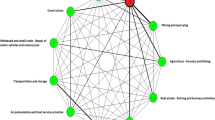Abstract
The dynamic relationship linking the volatility of equity prices with “the news” and the expected path for monetary policy is investigated. Previous results that link the impact of the news about real activity to changes in current and future interest rates are employed in developing a positive link between changes in volatility and the news. Empirically, our results uncover a positive and statistically significant response of the CBOE volatility index, VIX, to unanticipated changes in employment, but not to inflation. Hence, agents' expectations for the policy response to news have an important influence on the expected volatility of stock prices. (JEL E44, E52)
Similar content being viewed by others
References
Binder, John J., and Matthias J. Merges. 2001. “Stock Market Volatility and Economic Factors.”Review of Quantitative Finance and Accounting 17: 5–26.
Black, Fischer, and Myron Scholes. 1973. “The Pricing of Options and Corporate Liabilities.”Journal of Political Economy 81: 637–659.
Blair, Bevan J., Ser-Huang Poon, and Stephen J. Taylor. 2001. “Forecasting S&P Volatility: The Incremental Information Content of Implied Volatilities and High Frequency Index Returns.”Journal of Econometric 105: 5–26.
Bomfim, Antulio N. 2003. “Pre-announcement Effects, News Effects, and Volatility: Monetary Policy and the Stock Market.”Journal of Banking and Finance 27: 133–151.
Brenner, Menachem, and Marti G. Subrahmanyam. 1988. “A Simple Formula to Compute the Implied Standard Deviation.”Financial Analysts Journal 44(5): 80–83.
Chambers, Donald R., and Sanjay K. Nawalkha. 2001. “An Improved Approach to Computing Implied Volatility.”Financial Review 38(3): 89–100.
Chance, Don M. 1989.An Introduction to Options and Futures. Chicago: Dryden Press.
Cook, Timothy, and Steven Korn. 1991. “The Reaction of Interest Rates to the Employment Report: The Role of Policy Anticipations.”Economic Review, Federal Reserve Bank of Richmond 77(5): 3–12.
Ederington, Louis H., and Jae H. Lee. 1993. “How Markets Process Information: News Releases and Volatility.”The Journal of Finance 48: 1161–1191.
— 1996. “The Creation and Resolution of Market Uncertainly: The Impact of Information Releases on Implied Volatility.”Journal of Financial and Quantitative Analysis 31: 513–539.
Engel, Charles, and Jeffrey Frankel. 1984. “Why Interest Rates React to Money Announcements: An Explanation from the Foreign Exchange Market.”Journal of Monetary Economics 13: 31–39.
Fleming, Jeff. 1998. “The Quality of Market Volatility Forecasts Implied by S&P 100 Index Option Prices.”Journal of Empirical Finance 5: 317–345.
Kearney, Adrienne A. 1996. “The Effect of Changing Monetary Policy Regimes on Stock Prices.”Journal of Macroeconomics 18: 429–447.
—. 2002. “The Changing Impact of Employment Announcements on Interest Rates.”Journal of Economics and Business 54: 415–429.
—, and Raymond E. Lombra. 2003. “Fed Funds Futures And The News.”Atlantic Economic Journal 31: 316–329.
Merton, Robert C. 1973. “The Theory Of Rational Option Pricing.”Bell Journal of Economics and Management Science 4: 141–183.
Pearce, Douglas K., and V. Vance Roley. 1985. “Stock Prices and Economic News.”Journal of Business 58: 49–67.
Ramchander, Sanjay, Marc W. Simpson, and Mukesh Chaudhry. 2003. “The Impact of Inflationary News on Money Market Yields and Volatilities.”Journal of Economics and Finance 27: 85–101.
Santomero, Anthony M. 1991. “Money Supply Announcements: A Retrospective.”Journal of Economics and Business 43: 1–23.
Strong, Robert A. 2001.Practical Investment Management. South-Western College Publishing Thomson Learning.
Whaley, Robert E. 1993. “Derivatives on Market Volatility: Hedging Tools Long Overdue.”Journal of Derivatives 1: 71–84.
— 2000. “The Investor Fear Gauge.”Journal of Portfolio Management 26: 12–17.
Author information
Authors and Affiliations
Corresponding author
Rights and permissions
About this article
Cite this article
Kearney, A.A., Lombra, R.E. Stock market volatility, the news, and monetary policy. J Econ Finan 28, 252–259 (2004). https://doi.org/10.1007/BF02761615
Issue Date:
DOI: https://doi.org/10.1007/BF02761615




